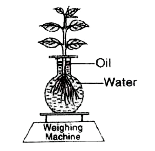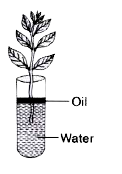Mention three adaptations found in plants to reduce transpiration.
Step-by-Step Solution:
1. Reduction of Leaf Size: Many plants, especially those in arid environments, have adapted by reducing the size of their leaves. In some cases, leaves are modified into spines or thorns, as seen in cacti. This adaptation minimizes the surface area from which water can be lost through transpiration.
2. Reduction in Number of Stomata: Another adaptation is the reduction in the number of stomata on the leaves. Stomata are small openings that allow for gas exchange but also facilitate water loss. By having fewer stomata, plants can significantly decrease the amount of water lost through transpiration.
3. Waxy Cuticle Layer: The third adaptation is the presence of a waxy layer on the surface of the leaves, known as the cuticle. This cuticle acts as a barrier to water loss, helping to retain moisture within the plant. The waxy nature of the cuticle prevents excessive transpiration by reducing the permeability of the leaf surface to water vapor.
Summary of Adaptations:
- Leaves reduced to spines (e.g., cacti).
- Fewer stomata on leaves.
- Presence of a waxy cuticle layer.
---
- Leaves reduced to spines (e.g., cacti).
- Fewer stomata on leaves.
- Presence of a waxy cuticle layer.
Topper's Solved these Questions
- TRANSPIRATIONBOOK - ICSECHAPTER - TRANSPIRATIONEXERCISE - CHOOSE THE CORRECT ANSWER
14 Videos
- TRANSPIRATIONBOOK - ICSECHAPTER - TRANSPIRATIONEXERCISE - COMPLETE THE FOLLOWING STATEMENTS
23 Videos
- STRUCTURE OF CHROMOSOMES , CELL CYCLE AND CELL DIVISION BOOK - ICSECHAPTER - STRUCTURE OF CHROMOSOMES , CELL CYCLE AND CELL DIVISION EXERCISE - ASSERTION & REASON
10 Videos
Similar Questions
The diagram below represents a process in plants. The setup was placed in bright sunlight. Answer the following questions :

Mention any three adaptations found in plants to overcome this process?
View SolutionStudy the diagram given below and answer the questions that follow :

Mention any three adaptations found in plants to overcome the process studied in the experiment. .
View SolutionGiven below is an experimental set-up to demonstrate a particular process. Study the same and answer the questions that follow :

Mention any three adaptations found in plants to overcome the physiological process mentioned in being studied.
View SolutionMention any three adaptations found in plants to favour the process of photosynthesis.
View SolutionName the adaptations found in
aerial plants
View SolutionName the adaptations found in
birds
View SolutionAdaptation of water plants.
View SolutionMention the adaptations shown by aquatic animals.
View SolutionName the adaptations found in
trees found in mountain regions
View SolutionName the adaptations found in
penguins and polar bears,
View Solution
